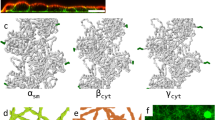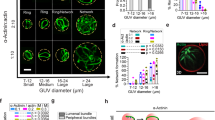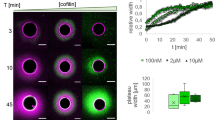Abstract
THE maintainance of the shape of cells is often due to their surface elasticity, which arises mainly from an actin-rich cytoplasmic cortex1,2. On locomotion, phagocytosis or fission, however, these cells become partially fluid-like. The finding of proteins that can bind to actin and control the assembly of, or crosslink, actin filaments, and of intracellular messages that regulate the activities of some of these actin-binding proteins, indicates that such 'gel–sol' transformations result from the rearrangement of cortical actin-rich networks3. Alternatively, on the basis of a study of the mechanical properties of mixtures of actin filaments and an Acanthamoeba actin-binding protein, α-actinin, it has been proposed that these transformations can be accounted for by rapid exchange of crosslinks between actin filaments4: the cortical network would be solid when the deformation rate is greater than the rate of crosslink exchange, but would deform or 'creep' when deformation is slow enough to permit crosslinker molecules to rearrange. Here we report, however, that mixtures of actin filaments and actin-binding protein (ABP), an actin crosslinking protein of many higher eukaryotes, form gels Theologically equivalent to covalently crosslinked networks. These gels do not creep in response to applied stress on a time scale compatible with most cell-surface movements. These findings support a more complex and controlled mechanism underlying the dynamic mechanical properties of cortical cytoplasm, and can explain why cells do not collapse under the constant shear forces that often exist in tissues.
This is a preview of subscription content, access via your institution
Access options
Subscribe to this journal
Receive 51 print issues and online access
$199.00 per year
only $3.90 per issue
Buy this article
- Purchase on Springer Link
- Instant access to full article PDF
Prices may be subject to local taxes which are calculated during checkout
Similar content being viewed by others
References
Bray, D. & White, J. G. Science 238, 883–888 (1988).
Stossel, T. P., Janmey, P. A. & Zaner, K. S. in Cytomechanics (eds Bereiter-Hahn, J., Anderson, O. R. & Reif, W. E.) 131–153 (Springer, Berlin, 1987).
Stossel, T. P. J. biol. Chem. 264, 18261–18264 (1989).
Sato, M., Schwartz, W. & Pollard, T. Nature 325, 828–830 (1987).
Hill, T. L. & Kirschner, M. W. Int. Rev. Cytol. 78, 1–125 (1982).
Doi, M. & Edwards, S. F. The Theory of Polymer Dynamics (Clarendon, Oxford, 1986).
Ferry, J. Viscoelastic Properties of Polymers (Wiley, New York, 1980).
Janmey, P. A. et al. Biochemistry 27, 8218–8227 (1988).
Janmey, P. A. & Stossel, T. P. J. Muscle Res. Cell Motil. 7, 446–454 (1986).
Weber, A., Northrop, J., Bishop, M. F., Ferrone, F. A. & Mooseker, M. S. Biochemistry 26, 2537–2544 (1987).
Hartwig, J. H. & Stossel, T. P. J. molec. Biol. 145, 563–581 (1981).
Zaner, K. S. J. biol. Chem. 261, 7615–7620 (1986).
Zaner, K. S. & Hartwig, J. H. J. biol. Chem. 263, 4532–4536 (1988).
Kwiatkowski, D. J., Janmey, P. A. & Yin, H. L. J. Cell Biol. 108, 1717–1726 (1989).
Janmey, P., Hvidt, S., Ferry, J. & Stossel, T. in Physical Networks (eds Burchard, W. & Ross-Murphy, S. B.) (Elsevier, Amsterdam, 1990).
Hvidt, S. & Janmey, P. Makromol. Chemie (in the press).
Janmey, P., Amis, E. & Ferry, J. J. Rheol. 27, 135–153 (1983).
Plazek, D., Vrancken, M. & Berge, J. Trans. Soc. Rheol. 2, 39–47 (1958).
Kouyama, T. & Mihashi, K. Eur. J. Biochem. 114, 33–38 (1981).
Green, N. M. Biochem. J. 89, 585–591 (1963).
Kishino, A. & Yanagida, T. Nature 334, 74–76 (1988).
Lodge, A. in Rheology of Elastomers (eds Mason, P. & Wooley, N.) 70–85 (Pergamon, New York, 1958).
Andrews, R., Tobolsky, A. & Hanson, E. J. appl. Phys. 17, 352–361 (1946).
Hartwig, J. H. & Shevlin, P. J. Cell Biol. 103, 1007–1028 (1986).
Wang, K. Biochemistry 16, 1857–1865 (1977).
Brotschi, E., Hartwig, J. & Stossel, T. J. biol. Chem. 253, 8988–8993 (1978).
Spudich, J. A. & Watt, S. J. biol. Chem. 246, 4866–4871 (1971).
Chaponnier, C., Janmey, P. A. & Yin, H. L. J. Cell Biol. 103, 1473–1481 (1986).
Author information
Authors and Affiliations
Rights and permissions
About this article
Cite this article
Janmey, P., Hvidt, S., Lamb, J. et al. Resemblance of actin-binding protein/actin gels to covalently crosslinked networks. Nature 345, 89–92 (1990). https://doi.org/10.1038/345089a0
Received:
Accepted:
Issue Date:
DOI: https://doi.org/10.1038/345089a0
This article is cited by
-
On the mechanical response of the actomyosin cortex during cell indentations
Biomechanics and Modeling in Mechanobiology (2020)
-
Heterogeneity, suspension, and yielding in sparse microfibrous cellulose gels 1. Bubble rheometer studies
Rheologica Acta (2019)
-
Material approaches to active tissue mechanics
Nature Reviews Materials (2018)
-
Mechanical instability at finite temperature
Nature Communications (2015)
-
Advances in the mechanical modeling of filamentous actin and its cross-linked networks on multiple scales
Biomechanics and Modeling in Mechanobiology (2014)
Comments
By submitting a comment you agree to abide by our Terms and Community Guidelines. If you find something abusive or that does not comply with our terms or guidelines please flag it as inappropriate.



